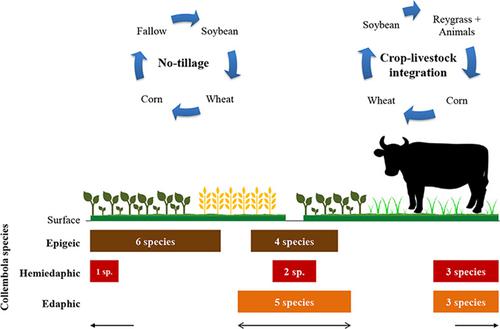当前位置:
X-MOL 学术
›
Ann. Appl. Biol.
›
论文详情
Our official English website, www.x-mol.net, welcomes your feedback! (Note: you will need to create a separate account there.)
Collembola community structure under different land management in subtropical Brazil
Annals of Applied Biology ( IF 2.6 ) Pub Date : 2020-07-06 , DOI: 10.1111/aab.12622 Luís Carlos Iuñes Oliveira Filho 1, 2 , Douglas Zeppelini 3 , José Paulo Sousa 4 , Dilmar Baretta 2 , Osmar Klauberg‐Filho 1
Annals of Applied Biology ( IF 2.6 ) Pub Date : 2020-07-06 , DOI: 10.1111/aab.12622 Luís Carlos Iuñes Oliveira Filho 1, 2 , Douglas Zeppelini 3 , José Paulo Sousa 4 , Dilmar Baretta 2 , Osmar Klauberg‐Filho 1
Affiliation

|
Tillage systems in conservation agriculture such as no‐tillage (NT) and crop‐livestock integration (CLI) have been proposed to limit the negative impacts of intensive agriculture. Soil organisms such as Collembola are good indicators because they respond to a variety of environmental and ecological factors and their community structure indicates a change in land management. In this study, we propose to assess the relationships between springtail biodiversity in management systems with a history of NT and CLI. For both management systems, nine points were sampled, distributed in a 30 × 30 m sampling grid, in three municipalities on the Southern Santa Catarina Plateau, Brazil. Springtails were collected using a metal cylinder (5 cm diameter × 5 cm deep) and identified at the species level. At the same point, samples were collected to evaluate soil properties (chemical, physical and microbiological). In total, 538 individuals were collected, distributed in 24 species, 293 individuals (18 species) in NT and 245 individuals (17 species) in the CLI system. Soil management systems studied did not affect the total number of individuals and richness. The NT system had a greater association with epigeic species, while the CLI system was more associated with hemiedaphic and edaphic species, which is related to the site‐specific differences in soil conditions. In both soil management systems, the species were influenced by a range of soil properties. The species Isotomurus sp. 1 and Lepidocyrtus sp. 1 were more influenced by soil properties in the NT system, while the species Proisotoma sp. 1, Sminthurinus sp. 1 and Tullbergia antarctica were more influenced by soil properties in the CLI system, compared to the others. Collembola community structure and species diversity were modified by the soil management systems. Our results suggest that the Collembola community may indicate changes across land management systems in conservation agriculture.
中文翻译:

亚热带巴西不同土地管理下的Collembola群落结构
已经提出了保护性农业的耕作制度,例如免耕(NT)和农作物-畜牧业一体化(CLI),以限制集约化农业的负面影响。Collembola等土壤生物是良好的指标,因为它们对各种环境和生态因素都有反应,并且其群落结构表明土地管理发生了变化。在这项研究中,我们建议评估具有NT和CLI历史的管理系统中spring鱼生物多样性之间的关系。对于这两种管理系统,在巴西南部圣卡塔琳娜高原的三个城市中,对9个点进行了采样,并分布在30×30 m的采样网格中。使用金属圆柱体(直径5厘米×深5厘米)收集跳虫,并在物种水平上进行识别。同时,收集样品以评估土壤性质(化学,物理和微生物学)。总共收集了538个个体,分布在24种中,在NT中为293个个体(18种),在CLI系统中则为245个个体(17种)。研究的土壤管理系统没有影响个体总数和丰富度。NT系统与表皮物种之间的联系更大,而CLI系统与半透明和深层物种的联系则更多,这与土壤条件的特定地点差异有关。在两种土壤管理系统中,物种都受到一系列土壤特性的影响。种类 NT系统中有293个人(18种),CLI系统中有245个人(17种)。研究的土壤管理系统没有影响个体总数和丰富度。NT系统与表皮物种之间的联系更大,而CLI系统与半透明和深层物种的联系则更多,这与土壤条件的特定地点差异有关。在两种土壤管理系统中,物种都受到一系列土壤特性的影响。种类 NT系统中有293个人(18种),CLI系统中有245个人(17种)。研究的土壤管理系统没有影响个体总数和丰富度。NT系统与表皮物种之间的联系更大,而CLI系统与半透明和深层物种的联系则更多,这与土壤条件的特定地点差异有关。在两种土壤管理系统中,物种都受到一系列土壤特性的影响。种类 该物种受到一系列土壤特性的影响。种类 该物种受到一系列土壤特性的影响。种类Isotomurus sp。1和Lepidocyrtus sp。1在NT系统中受土壤性质的影响更大,而Proisotoma sp。1,Sminthurinus sp。与其他相比,CLI系统中的土壤特性对图1和南极南芥属的影响更大。Collembola群落结构和物种多样性已通过土壤管理系统进行了修改。我们的结果表明,Collembola群落可能表明保护性农业的整个土地管理系统发生了变化。
更新日期:2020-07-06
中文翻译:

亚热带巴西不同土地管理下的Collembola群落结构
已经提出了保护性农业的耕作制度,例如免耕(NT)和农作物-畜牧业一体化(CLI),以限制集约化农业的负面影响。Collembola等土壤生物是良好的指标,因为它们对各种环境和生态因素都有反应,并且其群落结构表明土地管理发生了变化。在这项研究中,我们建议评估具有NT和CLI历史的管理系统中spring鱼生物多样性之间的关系。对于这两种管理系统,在巴西南部圣卡塔琳娜高原的三个城市中,对9个点进行了采样,并分布在30×30 m的采样网格中。使用金属圆柱体(直径5厘米×深5厘米)收集跳虫,并在物种水平上进行识别。同时,收集样品以评估土壤性质(化学,物理和微生物学)。总共收集了538个个体,分布在24种中,在NT中为293个个体(18种),在CLI系统中则为245个个体(17种)。研究的土壤管理系统没有影响个体总数和丰富度。NT系统与表皮物种之间的联系更大,而CLI系统与半透明和深层物种的联系则更多,这与土壤条件的特定地点差异有关。在两种土壤管理系统中,物种都受到一系列土壤特性的影响。种类 NT系统中有293个人(18种),CLI系统中有245个人(17种)。研究的土壤管理系统没有影响个体总数和丰富度。NT系统与表皮物种之间的联系更大,而CLI系统与半透明和深层物种的联系则更多,这与土壤条件的特定地点差异有关。在两种土壤管理系统中,物种都受到一系列土壤特性的影响。种类 NT系统中有293个人(18种),CLI系统中有245个人(17种)。研究的土壤管理系统没有影响个体总数和丰富度。NT系统与表皮物种之间的联系更大,而CLI系统与半透明和深层物种的联系则更多,这与土壤条件的特定地点差异有关。在两种土壤管理系统中,物种都受到一系列土壤特性的影响。种类 该物种受到一系列土壤特性的影响。种类 该物种受到一系列土壤特性的影响。种类Isotomurus sp。1和Lepidocyrtus sp。1在NT系统中受土壤性质的影响更大,而Proisotoma sp。1,Sminthurinus sp。与其他相比,CLI系统中的土壤特性对图1和南极南芥属的影响更大。Collembola群落结构和物种多样性已通过土壤管理系统进行了修改。我们的结果表明,Collembola群落可能表明保护性农业的整个土地管理系统发生了变化。



























 京公网安备 11010802027423号
京公网安备 11010802027423号